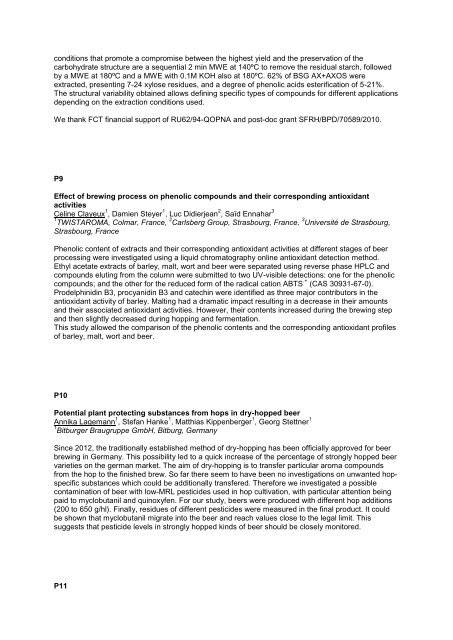here - the 34th European Brewery Convention
here - the 34th European Brewery Convention
here - the 34th European Brewery Convention
You also want an ePaper? Increase the reach of your titles
YUMPU automatically turns print PDFs into web optimized ePapers that Google loves.
conditions that promote a compromise between <strong>the</strong> highest yield and <strong>the</strong> preservation of <strong>the</strong><br />
carbohydrate structure are a sequential 2 min MWE at 140ºC to remove <strong>the</strong> residual starch, followed<br />
by a MWE at 180ºC and a MWE with 0.1M KOH also at 180ºC. 62% of BSG AX+AXOS were<br />
extracted, presenting 7-24 xylose residues, and a degree of phenolic acids esterification of 5-21%.<br />
The structural variability obtained allows defining specific types of compounds for different applications<br />
depending on <strong>the</strong> extraction conditions used.<br />
We thank FCT financial support of RU62/94-QOPNA and post-doc grant SFRH/BPD/70589/2010.<br />
P9<br />
Effect of brewing process on phenolic compounds and <strong>the</strong>ir corresponding antioxidant<br />
activities<br />
Celine Clayeux 1 , Damien Steyer 1 , Luc Didierjean 2 , Saïd Ennahar 3<br />
1 TWISTAROMA, Colmar, France, 2 Carlsberg Group, Strasbourg, France, 3 Université de Strasbourg,<br />
Strasbourg, France<br />
Phenolic content of extracts and <strong>the</strong>ir corresponding antioxidant activities at different stages of beer<br />
processing were investigated using a liquid chromatography online antioxidant detection method.<br />
Ethyl acetate extracts of barley, malt, wort and beer were separated using reverse phase HPLC and<br />
compounds eluting from <strong>the</strong> column were submitted to two UV-visible detections: one for <strong>the</strong> phenolic<br />
compounds; and <strong>the</strong> o<strong>the</strong>r for <strong>the</strong> reduced form of <strong>the</strong> radical cation ABTS .+ (CAS 30931-67-0).<br />
Prodelphinidin B3, procyanidin B3 and catechin were identified as three major contributors in <strong>the</strong><br />
antioxidant activity of barley. Malting had a dramatic impact resulting in a decrease in <strong>the</strong>ir amounts<br />
and <strong>the</strong>ir associated antioxidant activities. However, <strong>the</strong>ir contents increased during <strong>the</strong> brewing step<br />
and <strong>the</strong>n slightly decreased during hopping and fermentation.<br />
This study allowed <strong>the</strong> comparison of <strong>the</strong> phenolic contents and <strong>the</strong> corresponding antioxidant profiles<br />
of barley, malt, wort and beer.<br />
P10<br />
Potential plant protecting substances from hops in dry-hopped beer<br />
Annika Lagemann 1 , Stefan Hanke 1 , Matthias Kippenberger 1 , Georg Stettner 1<br />
1 Bitburger Braugruppe GmbH, Bitburg, Germany<br />
Since 2012, <strong>the</strong> traditionally established method of dry-hopping has been officially approved for beer<br />
brewing in Germany. This possibility led to a quick increase of <strong>the</strong> percentage of strongly hopped beer<br />
varieties on <strong>the</strong> german market. The aim of dry-hopping is to transfer particular aroma compounds<br />
from <strong>the</strong> hop to <strong>the</strong> finished brew. So far t<strong>here</strong> seem to have been no investigations on unwanted hopspecific<br />
substances which could be additionally transfered. T<strong>here</strong>fore we investigated a possible<br />
contamination of beer with low-MRL pesticides used in hop cultivation, with particular attention being<br />
paid to myclobutanil and quinoxyfen. For our study, beers were produced with different hop additions<br />
(200 to 650 g/hl). Finally, residues of different pesticides were measured in <strong>the</strong> final product. It could<br />
be shown that myclobutanil migrate into <strong>the</strong> beer and reach values close to <strong>the</strong> legal limit. This<br />
suggests that pesticide levels in strongly hopped kinds of beer should be closely monitored.<br />
P11





